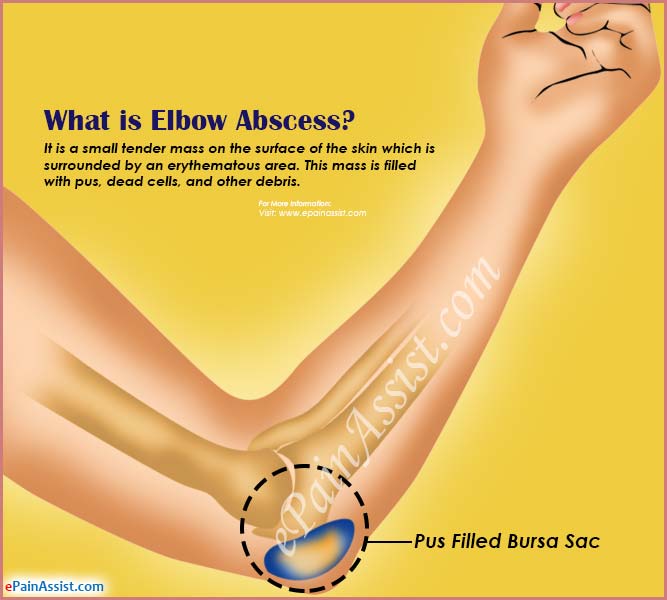What is Elbow Abscess?
To better understand an Elbow Abscess it is important to understand what exactly is abscess. An abscess is a small tender mass on the surface of the skin which is surrounded by an erythematous area. This mass is filled with pus, dead cells, and other debris. Abscess may occur in any part of the body but generally they occur in the armpits, the rectal area, base of the spine, around a tooth. When there is formation of abscess around the elbow region then it is termed as Elbow Abscess.
In some cases, an uprooted hair follicle around the elbow region also causes inflammation resulting in development of Elbow Abscess. Since the cause of Abscess is an inflammatory process which is more often than not caused by an infection, antibiotics are the most preferred treatment. Apart from antibiotics to curtain the infection, draining of the pus which forms the crux or the center of the abscess also needs to be drained out to completely heal the elbow abscess.

What are the Causes of Elbow Abscess?
Elbow Abscess is basically caused by obstruction of sweat glands around the elbow region, inflammation of hair follicles, or minor traumas or breaks in the skin in the elbow area which can occur during playing or being injured by a sharp object like a nail on the wall etc. When this happens, the germs present in the atmosphere infiltrate the skin and get into the sweat glands which swiftly trigger an inflammatory response as the body gets ready to fight and eliminate these germs. Because of this, there is development of Elbow Abscess.
The center or middle of the abscess contains mostly dead cells, bacteria, and other contaminants which is in the form of a liquid and is termed as pus. Gradually, this area begins to grow and thus creates pressure under the skin resulting in further inflammation of the surrounding tissues. This increased pressure and inflammation then results in severe pain. People who have a compromised immune system tend to get such abscesses more frequently. People with certain medical conditions like cancer, AIDS, diabetes are also at risk for getting Elbow Abscess due to their compromised immune state and even a little injury can trigger an inflammatory response.
What are the Symptoms of Elbow Abscess?
An individual with Elbow Abscess will have pain, erythema, and tenderness to touch around the elbow region. The individual will not be able to move the elbow through a full range of motion due to pain. As the condition progresses the center of the abscess may resemble a dot and you will be able to see the material inside the center of the abscess. In some cases, these abscesses spontaneously rupture draining pus but if they do not and the Elbow Abscess is not treated appropriately then the infection can spread to the surrounding tissues resulting in persistent intense pain and lack of function of the affected arm. An individual with Elbow Abscess will also not be able to use that hand effectively and hence will find it difficult to complete everyday tasks whether at home or at work. Fever may also develop if the infection spreads deeper into the tissues.
How is Elbow Abscess Diagnosed?
Before diagnosing Elbow Abscess, the treating physician will begin by asking the patient the following questions:
- What has been the duration of the Elbow Abscess
- Is there a history of an injury or direct trauma to the affected elbow
- The medications that are currently being taken
- History of any allergies
- Whether the patient has any fever.
The next thing the physician will do is to examine the surrounding area and look for a lymph gland around the elbow and armpit region in cases of Elbow Abscess. Blood test may be ordered to check how far the infection has spread so that it becomes easier to formulate a treatment plan to definitively treat Elbow Abscess.
Treatment for Elbow Abscess
The most preferred method for treating Elbow Abscess is draining the abscess. This will be done by first numbing the site of the abscess with lidocaine. In case if this local anesthetic does not work and the patient still feels pain then in such cases a sedative might have to be used. Area of the abscess will be covered with antiseptic solution and the abscess will be cut open to drain the pus that has been accumulated in the abscess. In majority of the cases of Elbow Abscesses, relief will be felt immediately. Additionally, in case of any pain, the physician may prescribe pain medication until the Elbow Abscess heals.
Prognosis for Elbow Abscess after Drainage of the Abscess?
The prognosis for Elbow Abscess is quite good once the abscess has been drained. In most cases, antibiotics are not required once the abscess has been drained. Improvement in pain is felt more after each passing day and the patient is able to regain range of motion of the elbow without any pain. Within three to four days, the patient can go back to normal activities after draining of an Elbow Abscess.
What are Some of the Do’s and Don’ts for Elbow Abscess?
Some of the dos and don’ts for Elbow Abscess are:
- You can apply warm compresses to the area of the Elbow Abscess for 15-20 minutes two to three times a day.
- Please do not try and drain the abscess by yourself as this may worsen the condition and the infection may spread deeper into the tissues causing further complications which may need more aggressive treatments
- Do not poke the center of the Elbow Abscess with a needle or anything sharp as this may injure an underlying blood vessel.
- Cleveland Clinic. (2021). Abscess https://my.clevelandclinic.org/health/diseases/17695-abscess
- Mayo Clinic. (2021). Boils and Carbuncles https://www.mayoclinic.org/diseases-conditions/boils-and-carbuncles/symptoms-causes/syc-20353770
